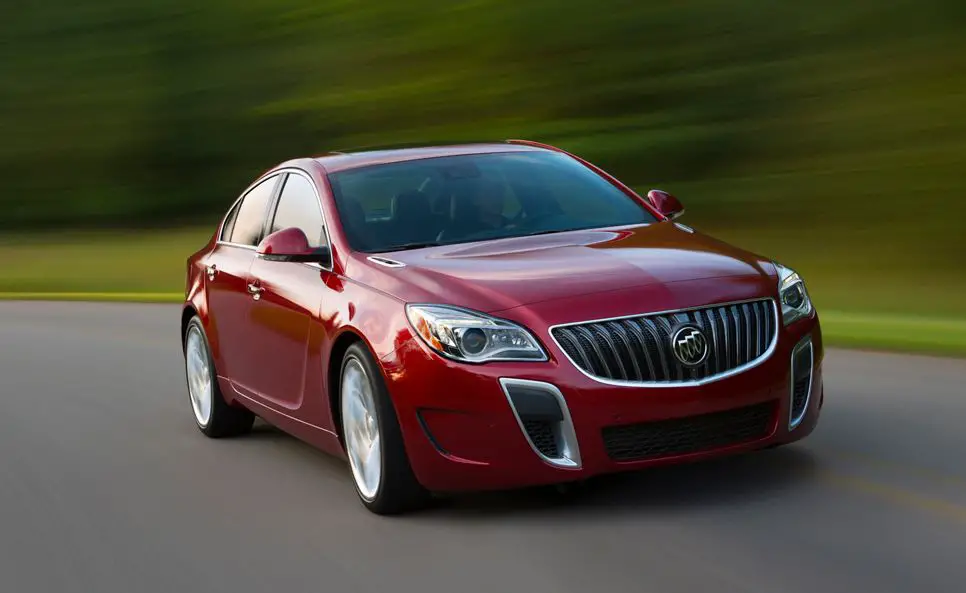Buick Regal 2014 Owner’s Manual
The 2014 Buick Regal is a stylish and sporty midsize sedan that combines luxury and speed. The Regal stands out on the road thanks to its sleek and elegant design. Its well-made interior makes driving easy and classy. The Regal has a choice of engines, including a turbocharged four-cylinder and a more powerful turbocharged V6. Both of these engines are efficient and work very well. It is easy to drive because the steering is quick and the ride is smooth. The Regal has a touchscreen infotainment system, Bluetooth connectivity, and available driver-assistance features like blind-spot tracking and lane departure warning. Overall, the 2014 Buick Regal is a good choice for people who want a stylish and fun midsize sedan. It hits a good balance between luxury and sportiness.
Electrical System
High Voltage Devices and Wiring
Warning
Exposure to high voltage can cause shock, burns, and even death. The high-voltage components in the vehicle can only be serviced by technicians with special training.
High-voltage components are identified by labels. Do not remove, open, take apart,
or modify these components. High voltage cable or wiring has orange covering. Do not probe, tamper with, cut, or modify high voltage cable or wiring.
Electrical System Overload
The vehicle has fuses and circuit breakers to protect against an electrical system overload. When the current electrical load is too heavy, the circuit breaker opens and closes, protecting the circuit until the current load returns to normal or the problem is fixed. This greatly reduces the chance of circuit overload and fire caused by electrical problems.
Fuses and circuit breakers protect power devices in the vehicle. Replace a bad fuse with a new one of identical size and rating.
If there is a problem on the road and a fuse needs to be replaced, the same amperage fuse can be borrowed. Choose some feature of the vehicle that is not needed to use and replace it as soon as possible.
Headlamp Wiring
An electrical overload may cause the lamps to go on and off, or in some cases to remain off. Have the headlamp wiring checked right away if the lamps go on and off or remain off.
Windshield Wipers
If the wiper motor overheats due to heavy snow or ice, the windshield wipers will stop until the motor cools and will then restart.
Although the circuit is protected from electrical overload, overload due to heavy snow or ice may cause wiper linkage damage. Always clear ice and heavy snow from the windshield before using the windshield wipers.
If the overload is caused by an electrical problem and not snow or ice, be sure to get it fixed.
Fuses and Circuit Breakers
The wiring circuits in the vehicle are protected from short circuits by a combination of fuses and circuit breakers. This greatly reduces the chance of damage caused by electrical problems.
To check a fuse, look at the silver-colored band inside the fuse. If the band is broken or melted, replace the fuse. Be sure to replace a bad fuse with a new one of identical size and rating.
Fuses of the same amperage can be temporarily borrowed from another fuse location if a fuse goes out. Replace the fuse as soon as possible.
To identify and check fuses, circuit breakers, and relays, see Engine Compartment Fuse Block on page 10-36 and Instrument Panel Fuse Block on page 10-39.
Engine Compartment Fuse Block
To remove the fuse block cover, press the three retaining clips on the cover and lift it straight up.
Wheels and Tires
Tires
Every new GM vehicle has high-quality tires made by a leading tire manufacturer. See the warranty manual for information regarding the tire warranty and where to get service. For additional information refer to the tire manufacturer.
Warning
- Poorly maintained and improperly used tires are dangerous.
- Overloading the tires can cause overheating as a result of too much flexing. There could be a blowout and a serious crash. See Vehicle Load Limits on page 9-10.
- Underinflated tires pose the same danger as overloaded tires. The resulting crash could cause serious injury. Check all tires frequently to maintain the recommended pressure. Tire pressure should be checked when the tires are cold.
- Overinflated tires are more likely to be cut, punctured, or broken by a sudden impact — such as when hitting a pothole. Keep tires at the recommended pressure.
- Worn or old tires can cause a crash. If the tread is badly worn, replace them.
- Replace any tires that have been damaged by impacts with potholes, curbs, etc.
- Improperly repaired tires can cause a crash. Only the dealer or an authorized tire service center should repair, replace, dismount, and mount the tires.
- Do not spin the tires in excess of 56 km/h
(35 mph) on slippery surfaces such as snow, mud, ice, etc. Excessive spinning may cause the tires to explode. See Tire Pressure for High-Speed Operation on
page 10-50 for inflation pressure adjustment for high-speed driving.
All-Season Tires?
This vehicle may come with all-season tires. These tires are designed to provide good overall performance on most road surfaces and weather conditions. Original equipment tires designed to GM’s specific tire performance criteria have a TPC specification code molded onto the sidewall. Original equipment all-season tires can be identified by the last two characters of this TPC code, which will be “MS.”
Consider installing winter tires on the vehicle if frequent driving on snow or ice-covered roads is expected. All-season tires provide adequate performance for most winter driving conditions, but they may not offer the same level of traction or performance as winter tires on snow or ice-covered roads. See Winter Tires on page 10-42.
Winter Tires
This vehicle was not originally equipped with winter tires. Winter tires are designed for increased traction on snow and ice-covered roads. Consider installing winter tires on the vehicle if frequent driving on ice or snow-covered roads is expected. See your dealer for details regarding winter tire availability and proper tire selection. Also, see Buying New Tires on page 10-57.
With winter tires, there may be decreased dry road traction, increased road noise, and shorter tread life. After changing to winter tires, be alert for changes in vehicle handling and braking. If using winter tires:
- Use tires of the same brand and tread type on all four-wheel positions.
- Use only radial ply tires of the same size, load range, and speed rating as the original equipment tires
Winter tires with the same speed rating as the original equipment tires may not be available for H, V, W, Y, and ZR speed-rated tires. If winter tires with a lower speed rating are chosen, never exceed the tire’s maximum speed capability.
Summer Tires
This vehicle may come with high-performance summer tires. These tires have special tread and compounds that are optimized for maximum dry and wet road performance. This special tread and compound will decrease performance in cold climates, and on ice and snow. We recommend installing winter tires on the vehicle if frequent driving in cold temperatures or on snow or ice-covered roads is expected. See Winter Tires on page 10-42.
Tire Sidewall Labeling
Useful information about a tire is molded into its sidewall. The examples show a typical passenger vehicle tire and a compact spare tire sidewall.
- Tire Size: The tire size is a combination of letters and numbers used to define a particular tire’s width, height, aspect ratio, construction type, and service description. See the “Tire Size” illustration later in this section.
- TPC Spec (Tire Performance Criteria Specification): Original equipment tires designed to GM’s specific tire performance criteria have a TPC specification code molded onto the sidewall. GM’s TPC specifications meet or exceed all federal safety guidelines.
- DOT (Department of Transportation): The Department of Transportation (DOT) code indicates that the tire is in compliance with the U.S. Department of
Transportation Motor Vehicle Safety Standards. - DOT Tire Date of Manufacture: The last four digits of the TIN indicate the tire manufactured date. The first two digits represent the week (01– 52) and the last two digits, the year. For example, the third week of the year 2010 would have a four-digit DOT date of 0310
- Tire Identification Number (TIN): The letters and numbers following the DOT (Department of Transportation) code are the Tire Identification Number (TIN). The TIN shows the manufacturer and plant code, tire size, and date the tire was manufactured. The TIN is molded onto both sides of the tire, although only one side may have the date of manufacture.
- Tire Ply Material: The type of cord and number of plies in the sidewall and under the tread.
- Uniform Tire Quality Grading (UTQG): Tire manufacturers are required to grade tires based on three performance factors: treadwear, traction, and temperature resistance. For more information see Uniform Tire Quality Grading on page 10-59.
- Maximum Cold Inflation Load Limit: Maximum load that can be carried and the maximum pressure needed to support that load.
FAQ
A1: The 2014 Buick Regal can accommodate up to five passengers.
A2: The 2014 Buick Regal offers two engine options: a 2.0-liter turbocharged four-cylinder engine and a 2.4-liter four-cylinder engine.
A3: Yes, all-wheel drive is available as an option on certain trims of the 2014 Buick Regal.
A4: The fuel efficiency of the 2014 Buick Regal varies depending on the engine and trim level, but it generally ranges from around 20 mpg in the city to 31 mpg on the highway.
A5: The 2014 Buick Regal comes with a six-speed automatic transmission.
A6: Yes, a rearview camera is a standard feature on the 2014 Buick Regal.
A7: The 2014 Buick Regal is available in several trim levels, including Base, Premium I, Premium II, and GS.
A8: Yes, the 2014 Buick Regal offers features such as a touchscreen infotainment system, Bluetooth connectivity, available navigation, and optional premium audio systems.
A9: Yes, heated seats are available as an option on certain trims of the 2014 Buick Regal.
A10: Yes, a power sunroof is available as an option on certain trims of the 2014 Buick Regal.
A11: The 2014 Buick Regal offers available safety features such as forward collision alert, lane departure warning, blind-spot monitoring, and rear cross-traffic alert.
A12: The 2014 Buick Regal offers a trunk capacity of approximately 14.2 cubic feet.
A13: Yes, the 2014 Buick Regal comes with a basic warranty of 4 years/50,000 miles and a powertrain warranty of 6 years/70,000 miles.
A14: The 2014 Buick Regal offers available luxury features such as leather upholstery, ventilated front seats, dual-zone automatic climate control, and a premium Bose sound system.
A15: Yes, the 2014 Buick Regal is praised for its sporty performance, especially in the higher trims like the Regal GS, which features a more powerful engine and enhanced suspension tuning.
Useful Link
Download Link: https://www.buick.com/support/vehicle/manuals-guides


